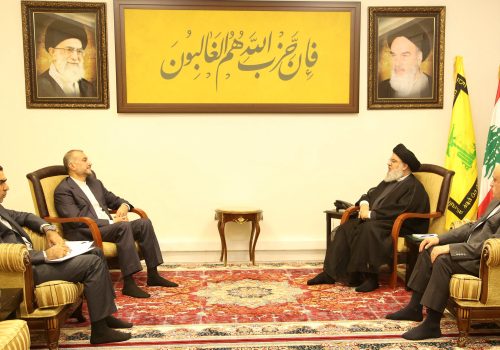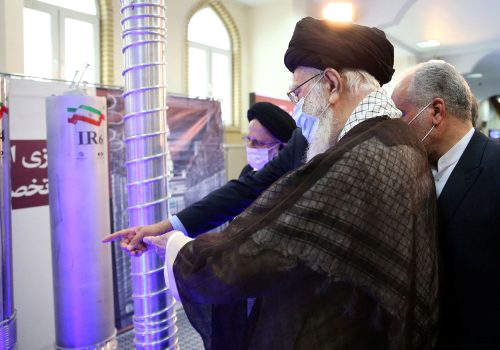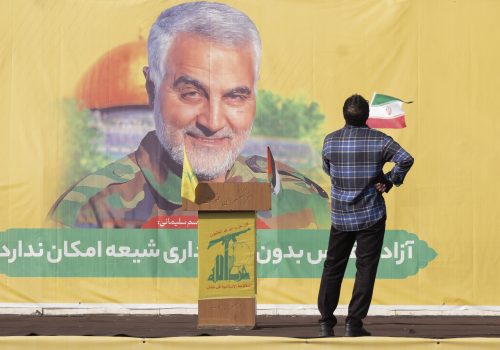The Gaza war is a reminder that the US needs to reevaluate its Iran policy
Iran-backed militia groups have attacked US forces in Iraq and Syria at least fifty-two times since October 17. However, the United States has responded by only issuing a few attacks on Iran-backed militia groups bases in Syria and not Iraq. These attacks come at a critical juncture as the Gaza war rages on, potentially reshaping the dynamics of power in the Middle East.
Despite the Joe Biden administration’s efforts to prevent a further escalation and the expansion of the Israel-Hamas war in the region, Iran-backed militia groups in Iraq, Syria, and Yemen continue to challenge US forces. This is particularly evident in Iraq, where Tehran controls most of the power after the Shia Coordination Framework, which it backs, took control of the government. This shadow war began in the 1980s after the establishment of Hezbollah in Lebanon, allowing Iran to avoid direct confrontation with the United States and Israel, especially since the Gaza war began. While Iran has successfully implemented this policy for an extended period, the new developments in the Israel-Hamas war may alter the status quo.
If these attacks continue, the United States might need to adjust its response. This change may involve either combating militia groups inside Iraq or directly confronting Iran. Another response potentially necessitates the evacuation of the US embassy in Baghdad and the withdrawal of its remaining 2,500 troops. If this happens, it could set a precedent for other countries to follow suit. This is where Iraq could face security and political crises, potentially leading to a civil war between rival Shia groups: the Popular Mobilization Forces (PMF) and its political allies; the Shia Coordination Framework; and their rival, Shia cleric Muqtada al-Sadr. Additionally, other terrorist groups, such as the Islamic State of Iraq and al-Sham (ISIS), could exploit the situation to regain power. The repercussions of this situation could spill over to other countries, possibly plunging the entire region into turmoil in the aftermath of the Gaza war.
The Gaza war erupted amid the United States’ attempt to reach an agreement with Iran to stop the latter’s provision of drones and missiles to Russia (for use against Ukraine) and to halt Iran’s nuclear program. This initiative followed the first concluded deal, which involved the release of five American hostages in exchange for the transfer of $6 billion in Iranian funds frozen in South Korean banks. Dealing with Iran’s policy, which involves supporting proxy groups and suppressing ongoing anti-establishment protests within Iran, was not a priority for the United States and Europe in recent years. This myopic policy of the White House has even strained the US’s relationship with its regional allies, such as Saudi Arabia and the United Arab Emirates (UAE).
However, Hamas’ attack on Israel on October 7 drew global attention to Iran’s support for proxy groups in the Middle East. It raised concerns about the potential expansion of the conflict based on Tehran’s calculations. This critical situation in the region underscores that the nuclear program should not be the sole issue of concern when dealing with Iran. Iran-backed proxy groups have the potential to escalate conflicts similar to what occurred after Hamas attacked Israel and can also lead to energy security issues, migration crises, and humanitarian disasters.
Moreover, the Gaza war is the first significant test for Iran in the post-Qasem Soleimani era. The assassinated Islamic Revolutionary Guard Corps (IRGC) Quds Force commander was a key figure in creating, controlling, and coordinating militia groups in the Middle East and empowering Iranian influence through these proxies in the region. Iran’s current policy of rejecting any involvement in Hamas’ attack on Israel, as well as attempts to avoid any expansion of the war on Iran, has forced the clerical establishment to offer only verbal support to Hamas—one of its Palestinian wings in the fight against Israel—risking losing credibility and influence in the region.
The failure of Lebanese Hezbollah to assist Hamas and prevent its loss of power in Gaza could further damage trust and relationships within Iran and its proxy network. During his speech on November 3, Secretary-General Hassan Nasrallah disappointed his supporters, who were eagerly awaiting his declaration of war against Israel. Instead, he stated that they have been in a state of war with Israel since October 8, indicating that Hezbollah’s current strategy involves continued skirmish attacks and not an escalation to a full-scale war. Given that Hezbollah is an Iran-created group that receives orders from Tehran, its lack of response reflects the clerical establishment’s stance for the time being.
Moreover, Iran’s inability to organize protests within the country in support of Palestinians—despite its sizable Muslim population of over 80 million—raises questions. Foreign Minister Hossein Amir-Abdollahian posted images of protests in Indonesia supporting Gaza, while Iran did not see similar, sizeable demonstrations. This could be attributed to two primary reasons. First, the regime may be struggling to mobilize large numbers of people to rally in support of Gaza. Second, the regime might perceive the potential for large protests as a threat to its control, particularly in the wake of the brutal crackdown on the 2022 Women, Life, Freedom uprising.
Iranians have consistently seized every opportunity to express their disagreement with their government’s policy of supporting Palestinian groups against Israel by utilizing Iranian resources and wealth. The chant, “Neither Gaza nor Lebanon, I will sacrifice my life for Iran,” started with anti-government protesters on Quds Day (Jerusalem Day) in 2009 as a response to government-sponsored demonstrations in support of Palestine. This sentiment persisted in subsequent protests in 2017, 2019, and 2022–2023 and will continue reverberating across Iran.
The ongoing situation in the Gaza war, coupled with the uncertainty about Iran’s potential decisions and orders to its proxy groups, highlights the urgency for the US to reassess its policy toward Iran. It is imperative to acknowledge and address the increasing influence of Iran-backed proxy groups in the region, facilitated by Tehran’s support. A critical first step should involve devising strategies to sever the link between Iran’s provision of support and funding for these proxy groups, thereby reshaping the geopolitical dynamics and mitigating potential regional crises.
Shukriya Bradost is a PhD student and researcher in international security at Virginia Tech University, specializing in Middle Eastern geopolitics.
Further reading
Thu, Oct 19, 2023
Israel misread Iran’s way of war. A proper understanding could help predict Hezbollah’s next moves.
IranSource By David Daoud
Iran—through Hezbollah—has spent almost two decades and considerable effort and funds building the Gaza Strip into the Axis of Resistance’s Southern Front against Israel.
Thu, Nov 9, 2023
The Gaza war probably won’t change Iran’s nuclear strategy. It’ll make it difficult to reach a long-term agreement, though.
IranSource By Danny Citrinowicz
For now, Iranian deterrence is working, since Tehran is not paying any price for its proxy activity.
Wed, Nov 8, 2023
The Gaza war raises questions about the future of Iran’s Resistance Axis
IranSource By
The Gaza war presents the first significant test of the level of cooperation present among the elements of the Iran-led Resistance Axis.
Image: Iranian President Ebrahim Raisi walks with Iraqi Prime Minister Mohammed Shia al-Sudani during a welcoming ceremony in Tehran, Iran, November 6, 2023. Iran's Presidency/WANA (West Asia News Agency)/Handout via REUTERS


